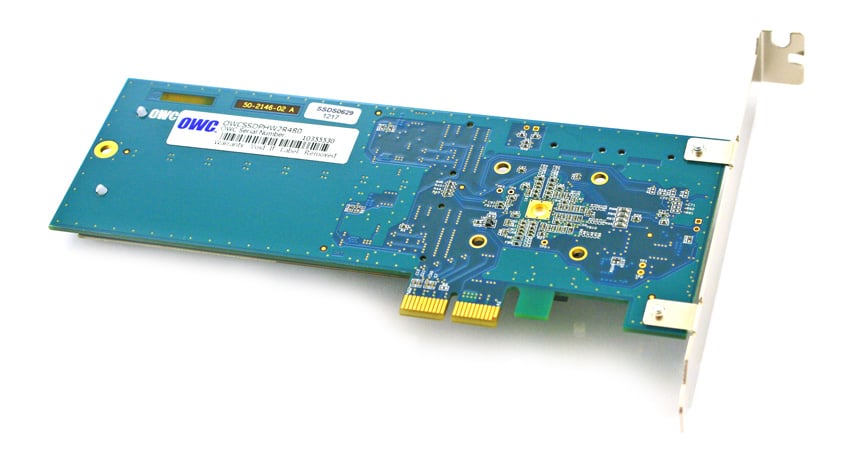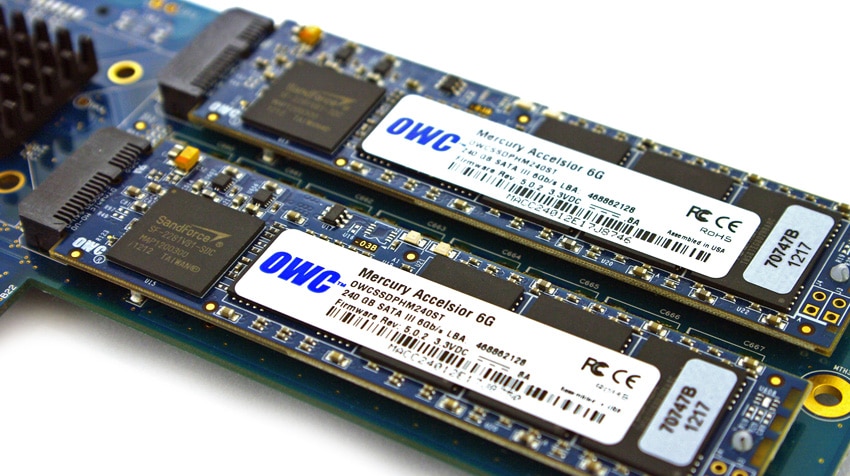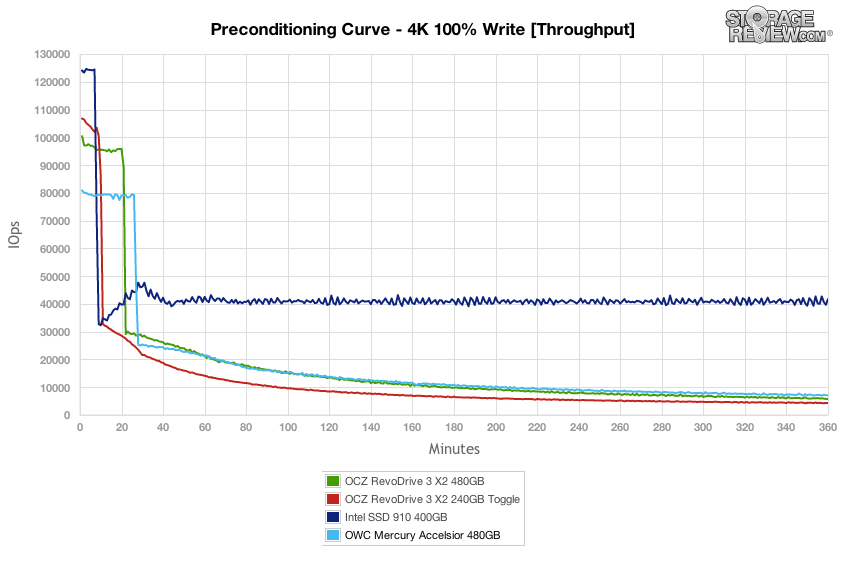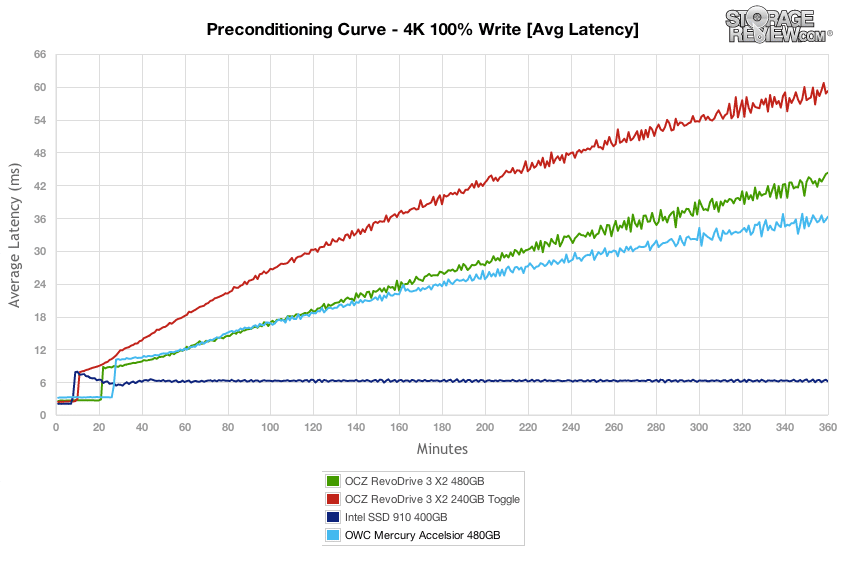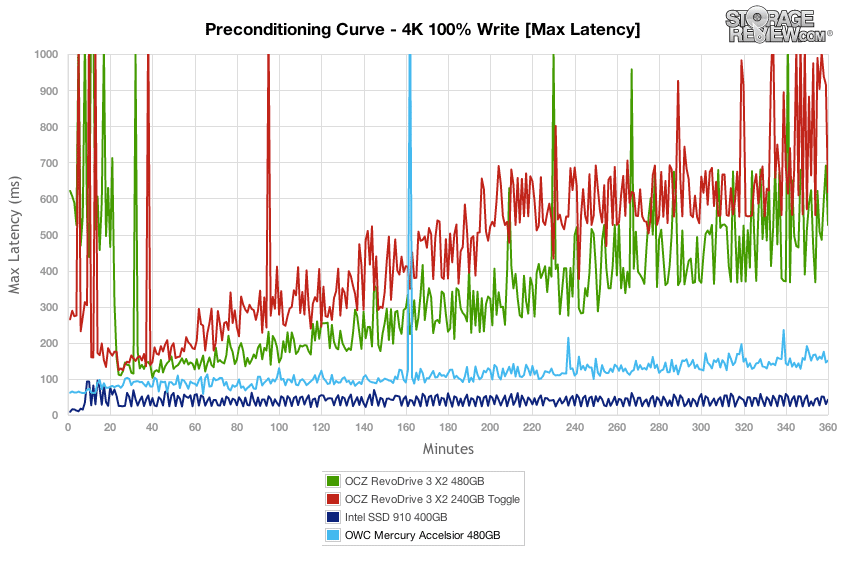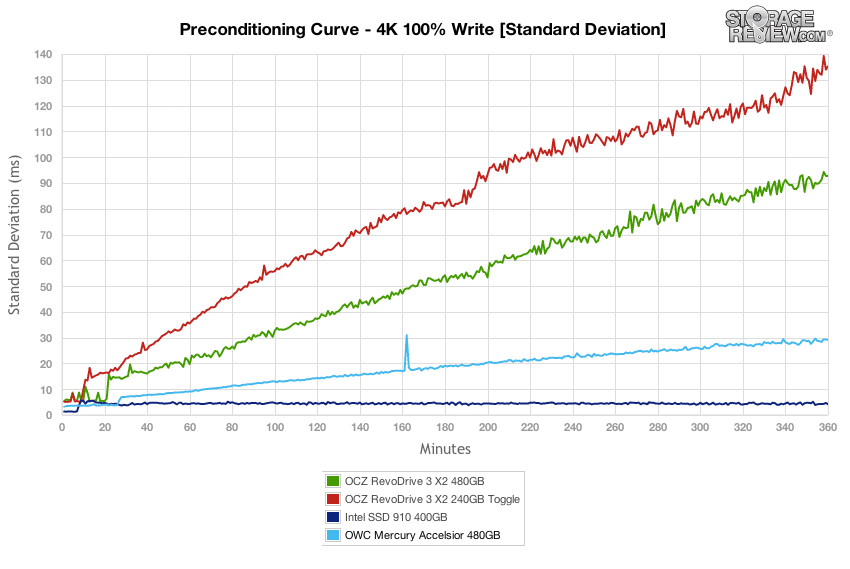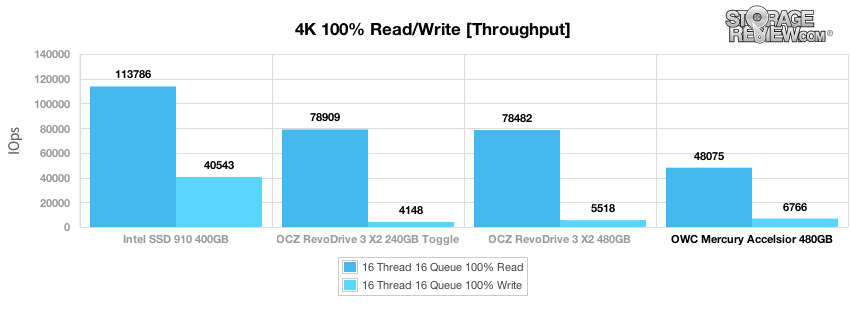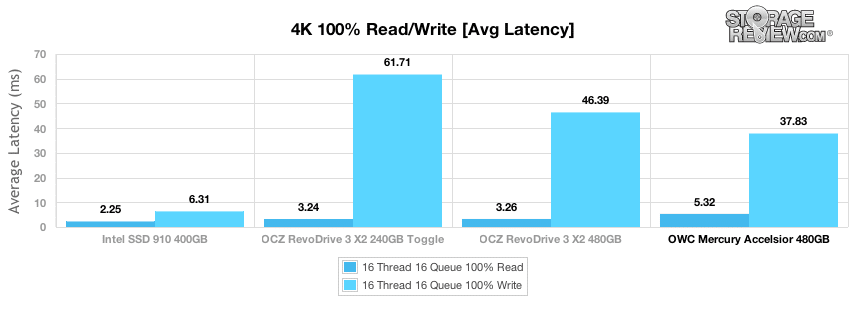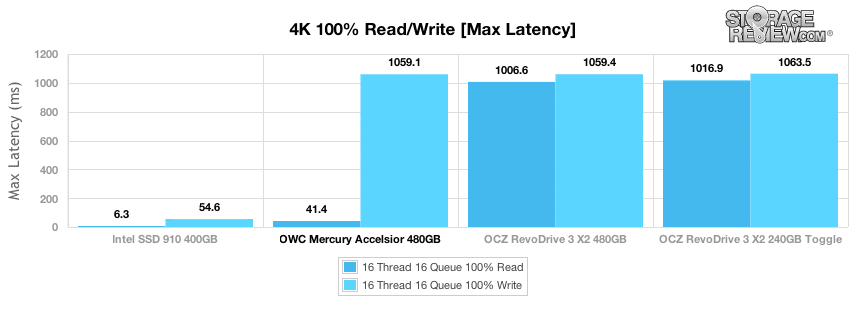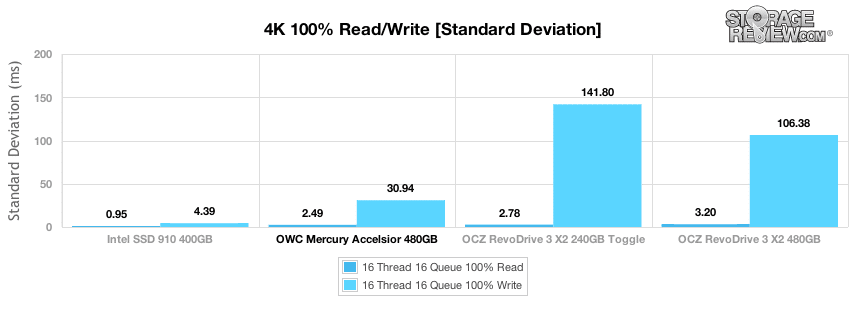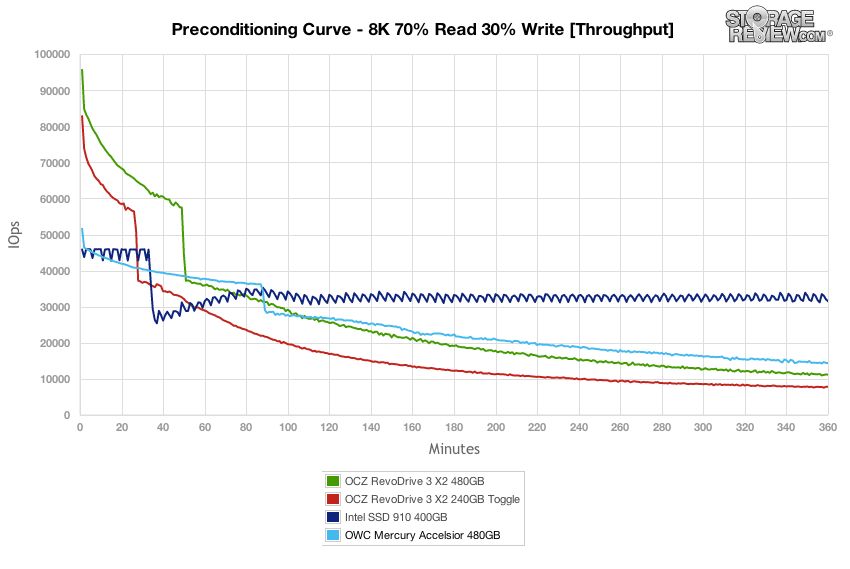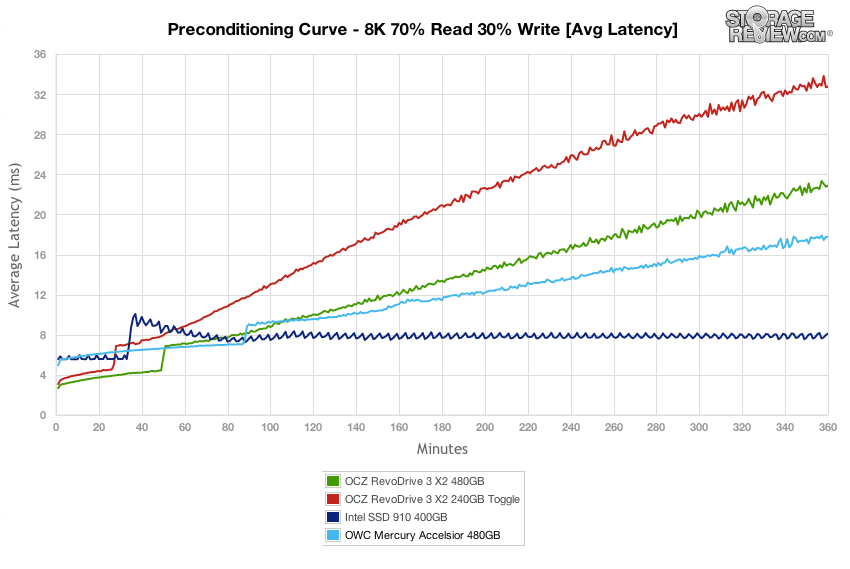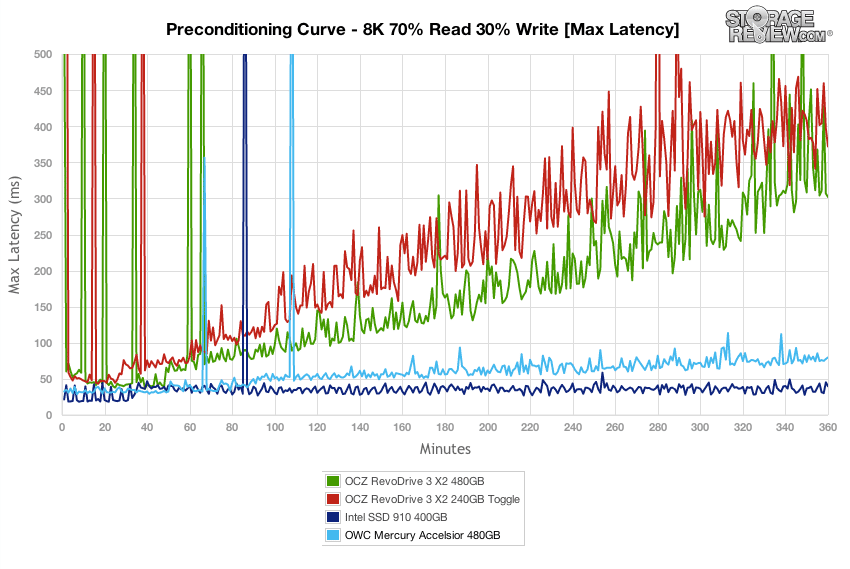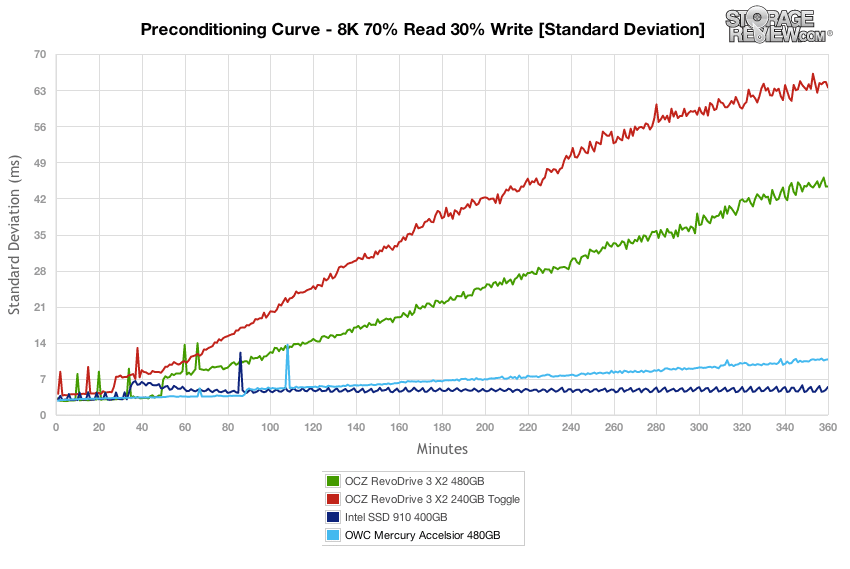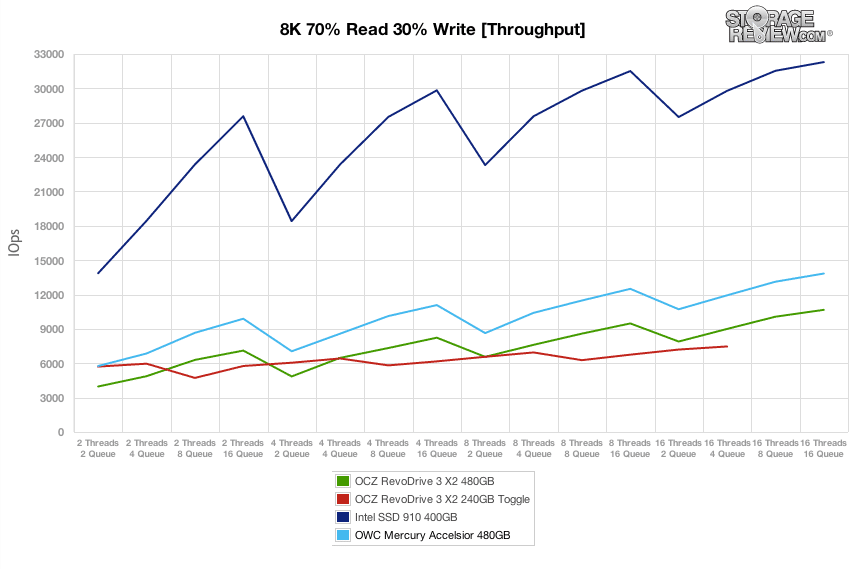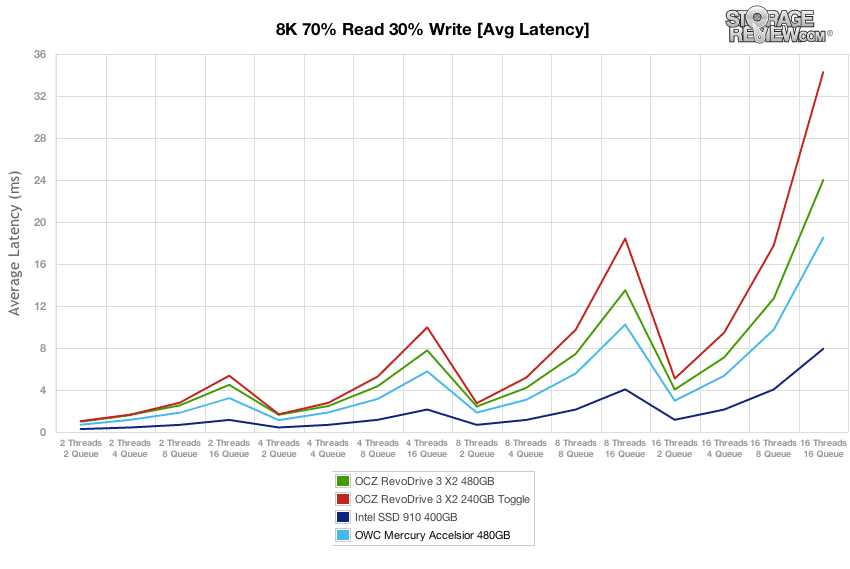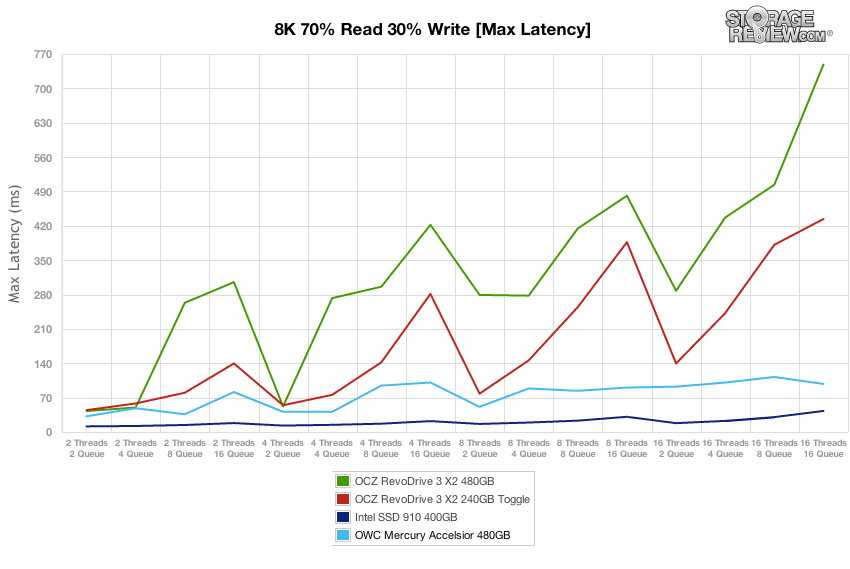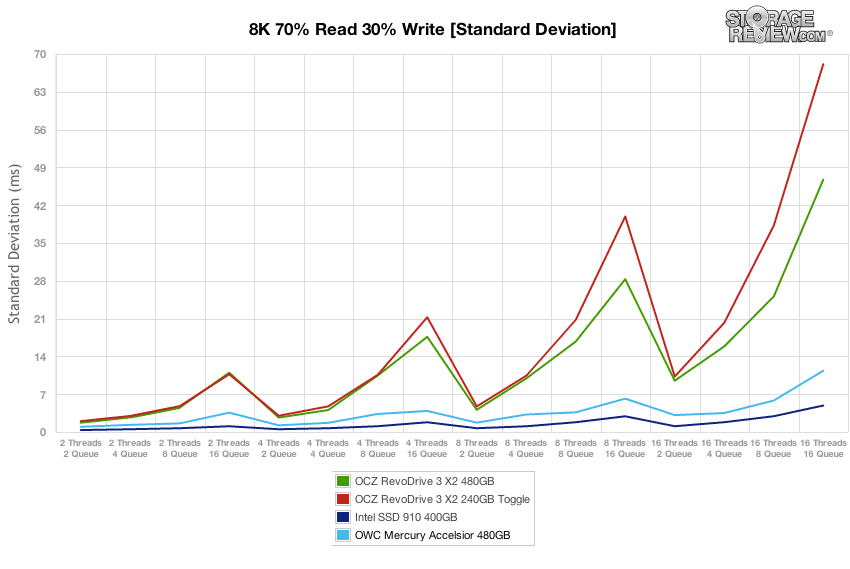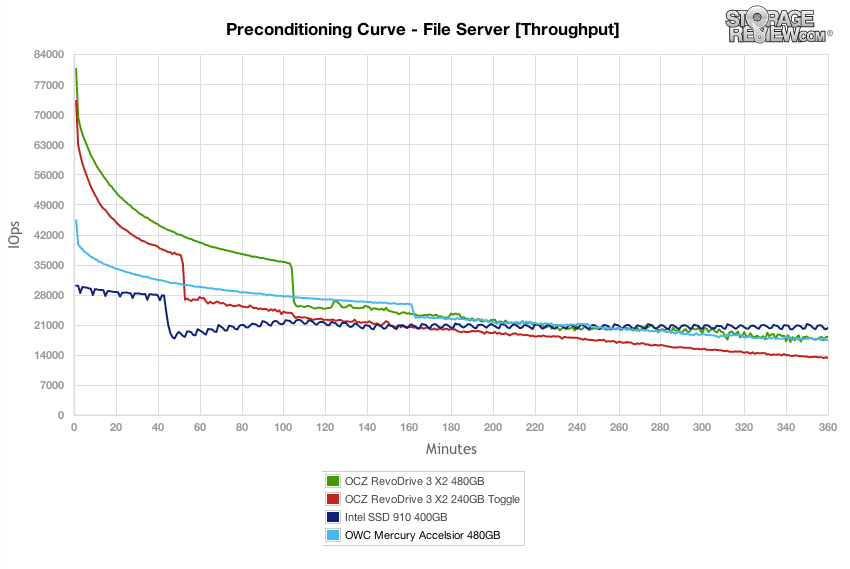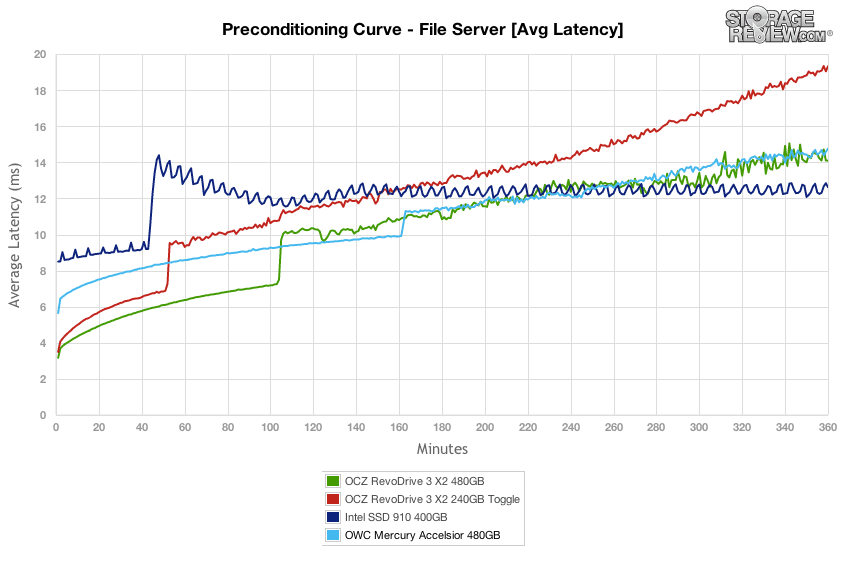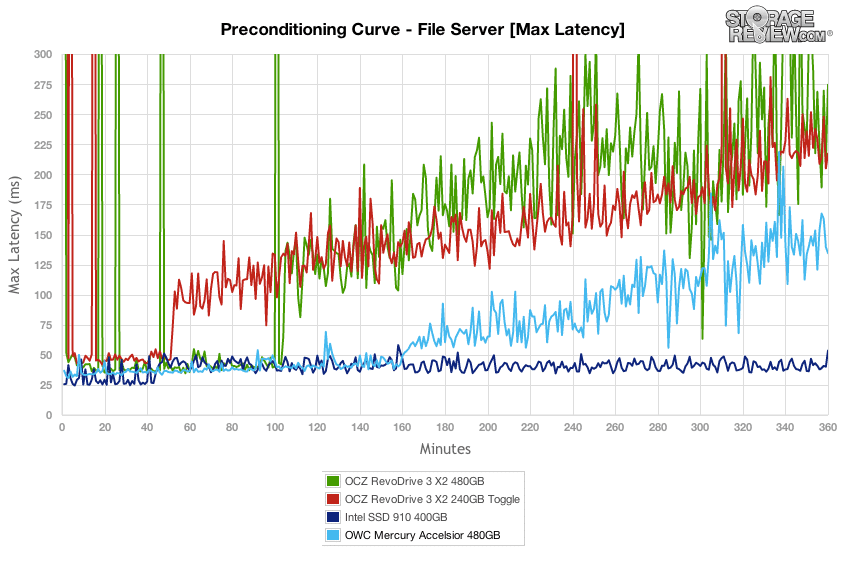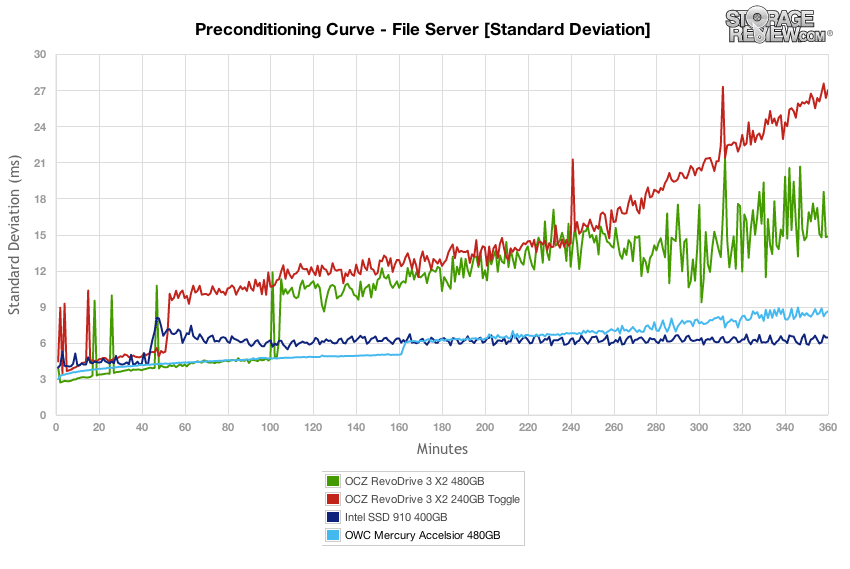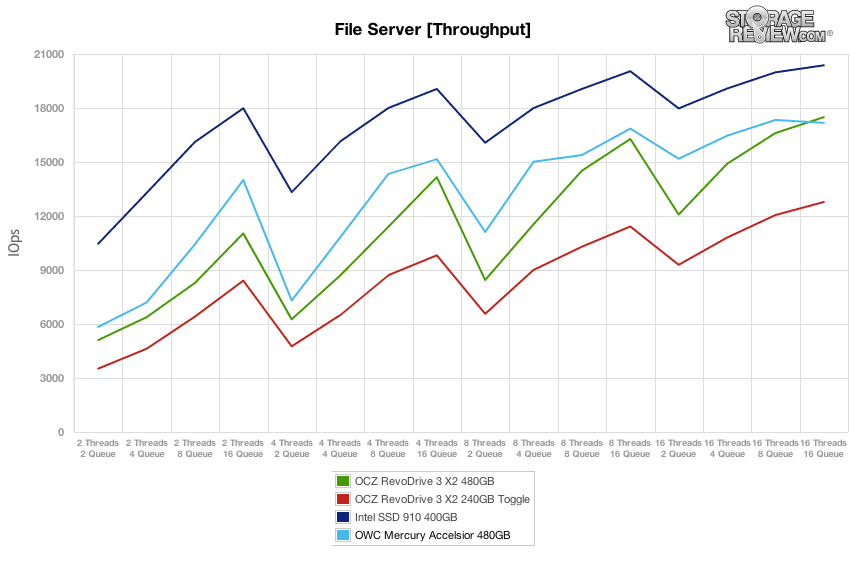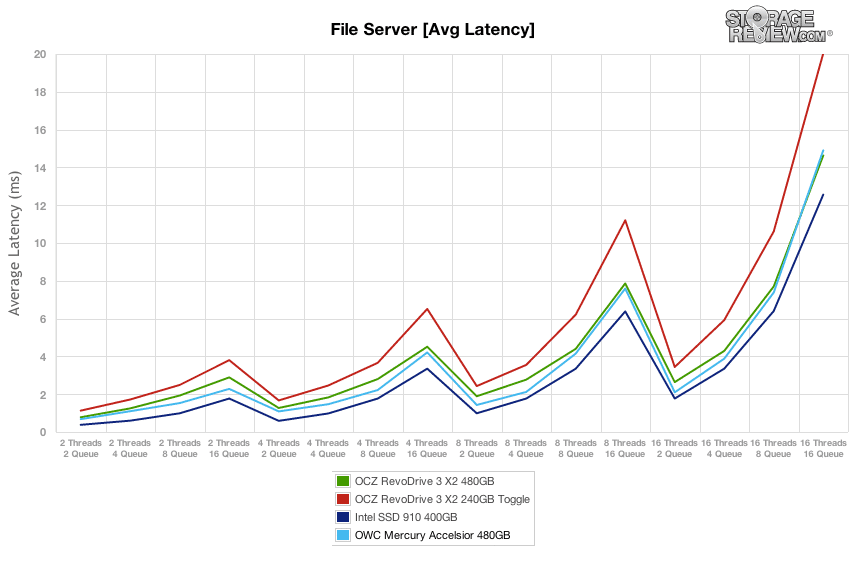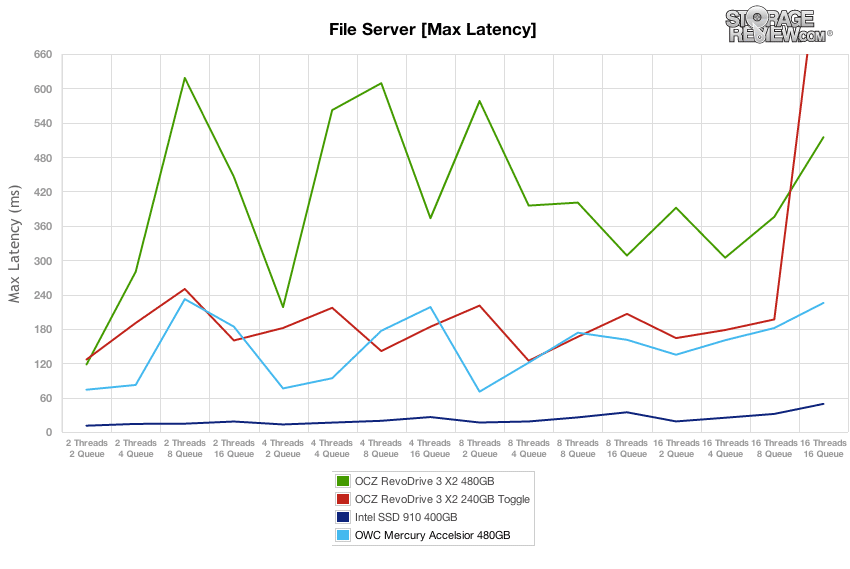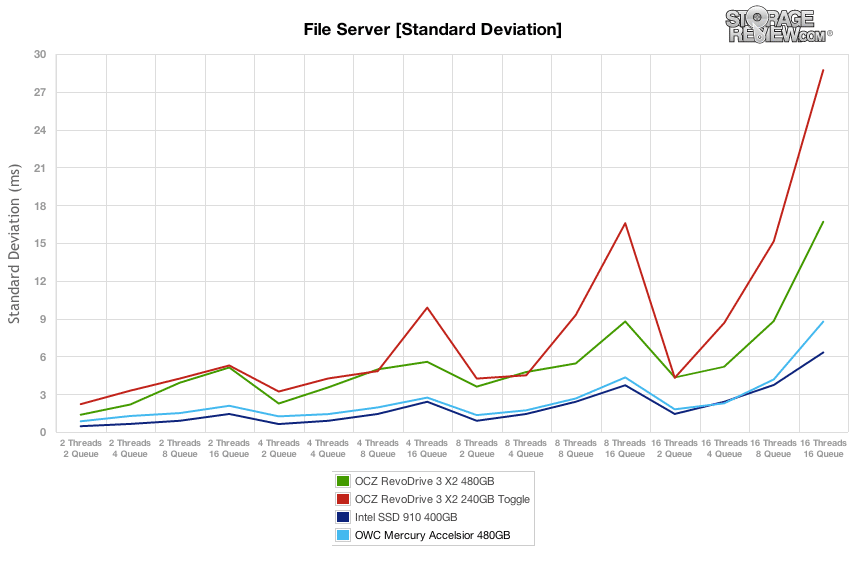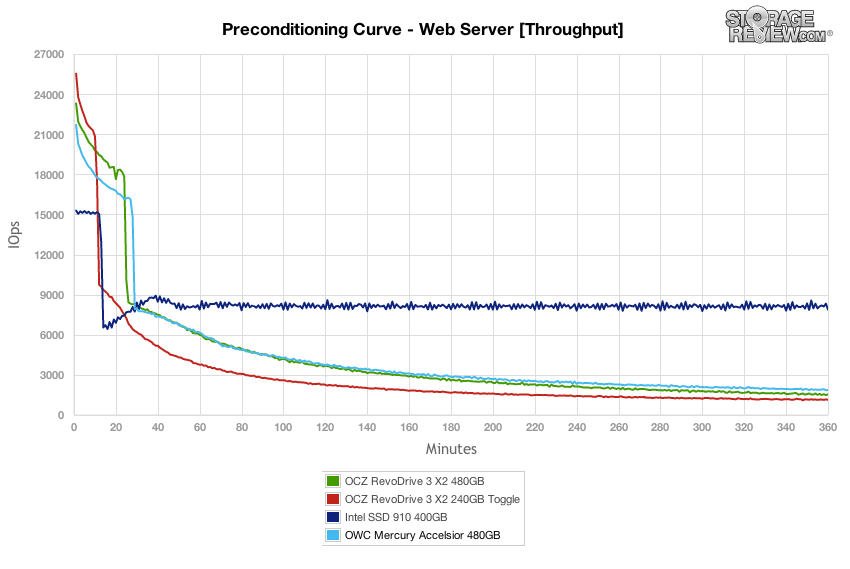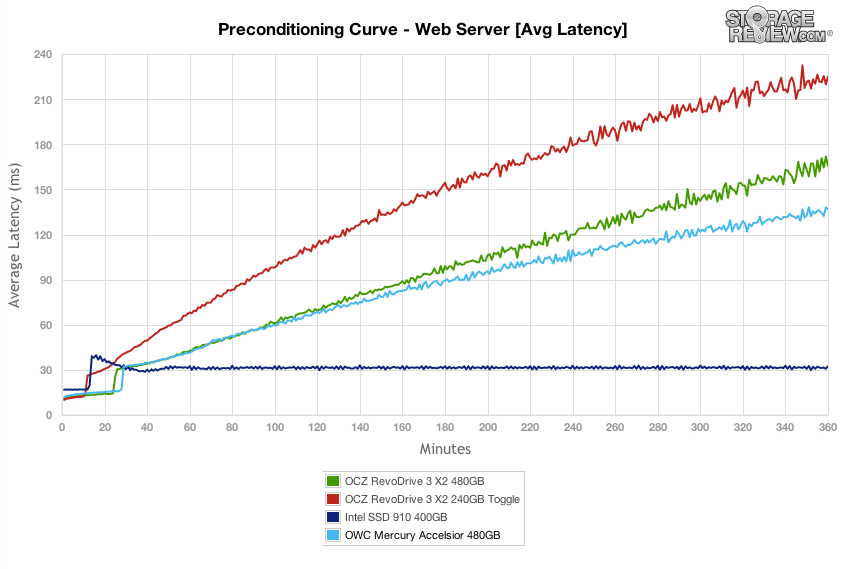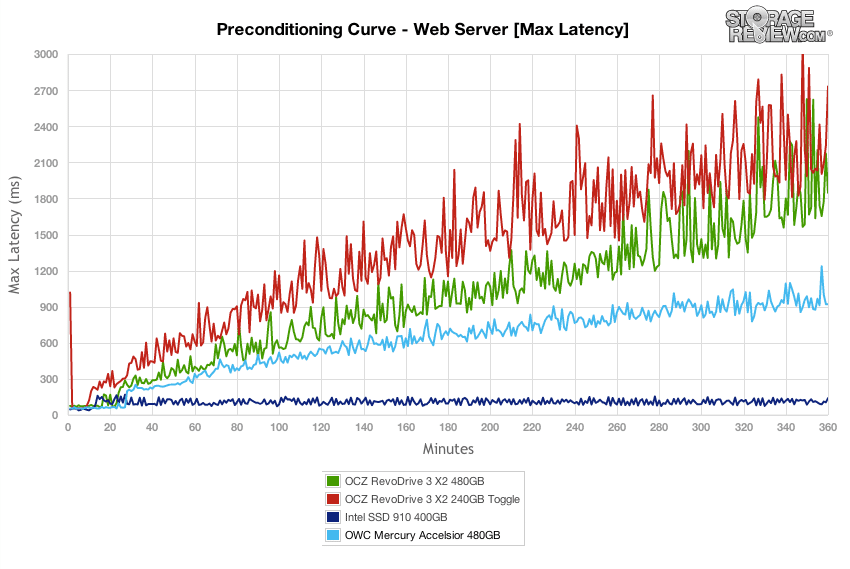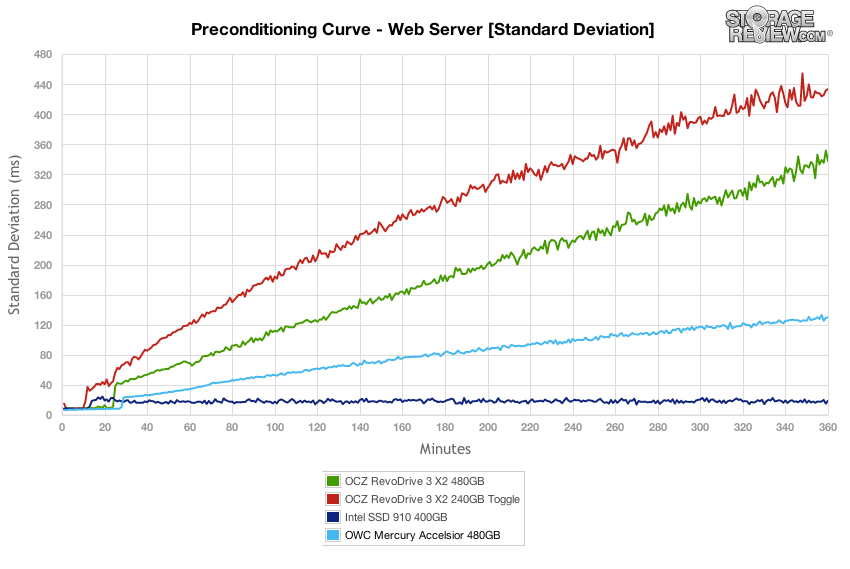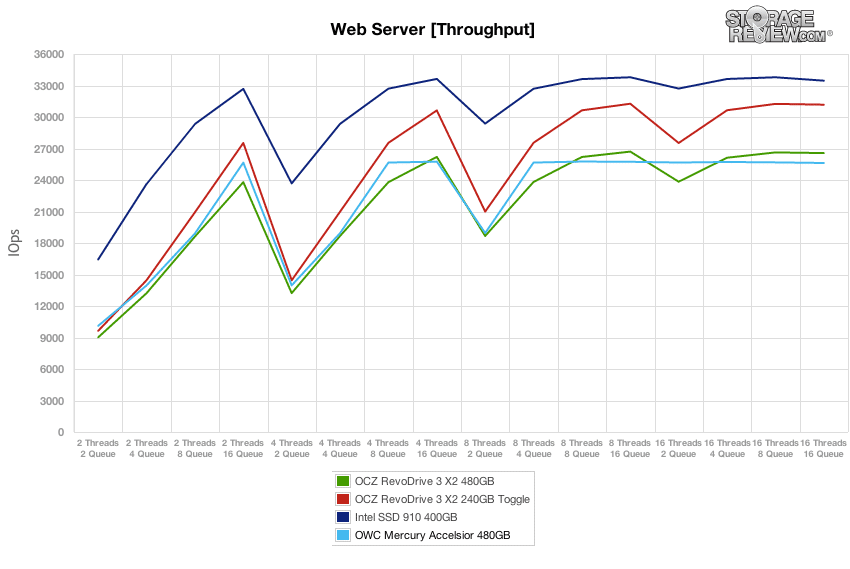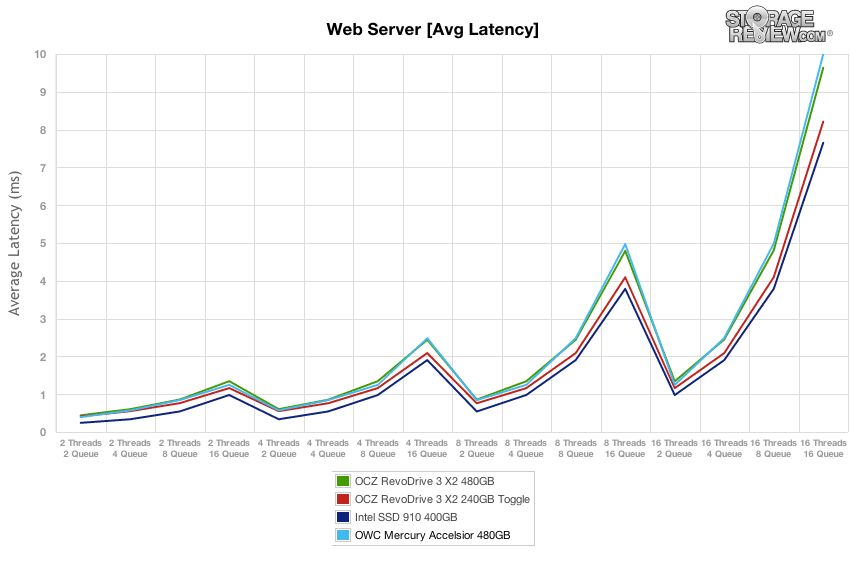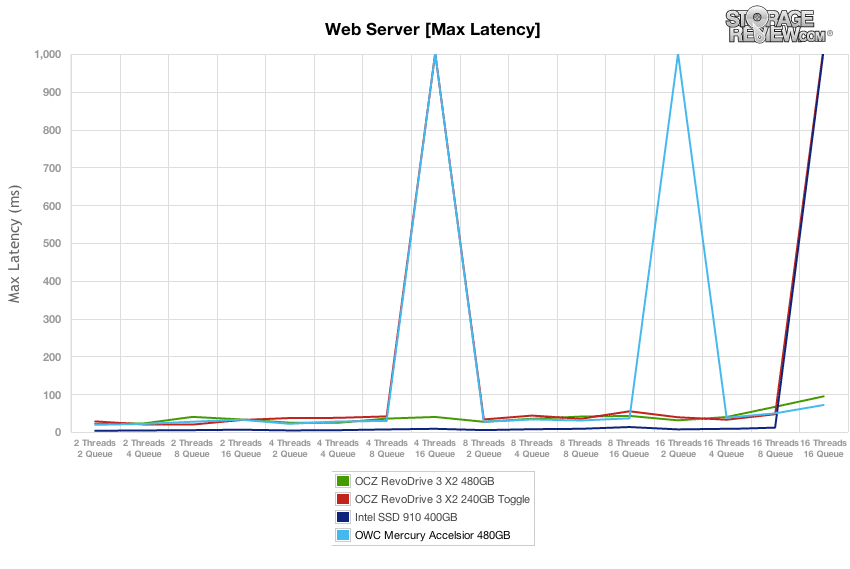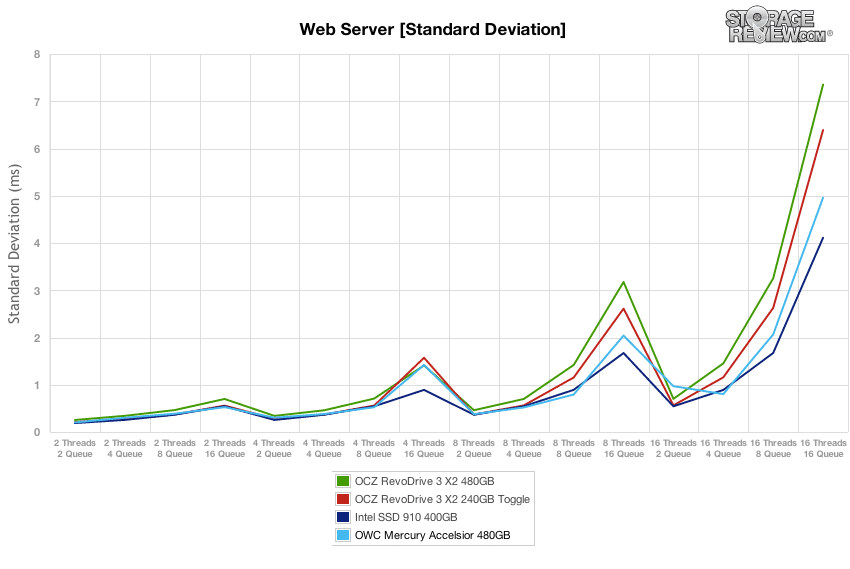
The OWC Mercury Accelsior is a PCIe SSD designed for the enthusiast and creative professional market who crave the fastest storage available within a client workstation. OWC uses a unique design, essentially leveraging a PCIe PCB with two host slots for their gumstick-shaped SSDs and a management controller that ties the drives together. The architecture itself isn’t novel, but OWC’s implementation is, using in-house components and engineering to make the Accelsior come to life. OWC also provides options for the user which are unique. By default the drives ship in a RAID0 configuration which offers throughput around 800MB/s; users also have ability to switch to RAID1 for data redundancy, or JBOD mode to access the individual drives.
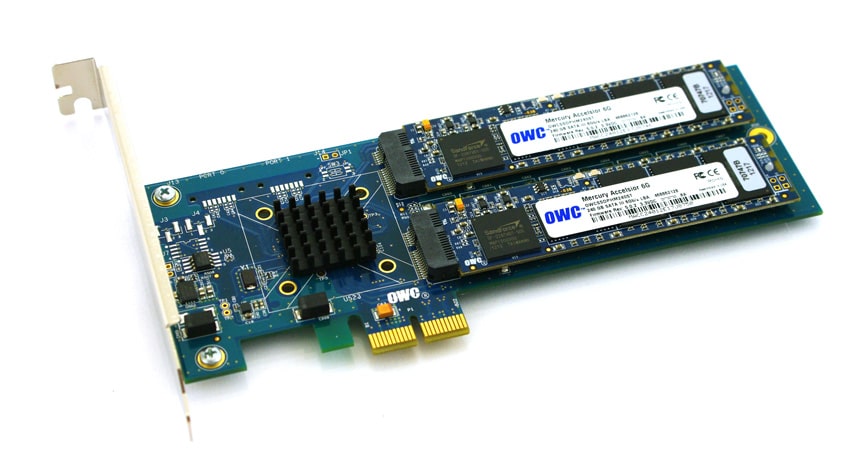
While the Accelsior certainly may find traction amongst the enthusiast computing audience, the core driver for this type of performance is around the creative professional space. Applications that are traditionally bound to some degree by storage performance thrive when able to access the type of throughput PCIe and two fast SandForce drives in RAID0 open up. From an end user standpoint, the notion of storage on a PCIe card is easy to understand and simply requires an open PCIe slot, rather than trying to manage multiple SSDs and a RAID card to drive similar performance. Of course OWC’s Mac heritage shows through with the Accelsior as well. While it will work in most any system, OWC has made the Accelsior bootable in Windows and Mac OSs, the latter being exclusive to OWC at this time. Drivers are also not required, adding to the ease of deployment message.
The Accelsior is available in 120GB, 240GB, 480GB and 960GB capacities with current pricing of $319.99, $495.99, $759.99 and $1529.99 respectively. The design does allow for user upgrades, should OWC offer larger capacity or faster drives in the future. OWC includes a three year warranty with each drive.
OWC Mercury Accelsior Specifications
- Capacities
- 120GB (SSDPHW2R120)
- Sustained Sandy Bridge Reads: up to 758MB/s
- Sustained Sandy Bridge Writes: up to 743MB/s
- Sustained Ivy Bridge Reads: up to 761MB/s
- Sustained Ivy Bridge Writes: up to 761MB/s
- Random 4K Read: up to 100,000 IOPS
- Random 4K Write: up to 100,000 IOPS
- Read/Write Latency: less than 0.1ms
- 240GB (SSDPHW2R240)
- Sustained Sandy Bridge Reads: up to 762MB/s
- Sustained Sandy Bridge Writes: up to 763MB/s
- Sustained Ivy Bridge Reads: up to 823MB/s
- Sustained Ivy Bridge Writes: up to 772MB/s
- Random 4K Read: up to 100,000 IOPS
- Random 4K Write: up to 100,000 IOPS
- Read/Write Latency: less than 0.1ms
- 480GB (SSDPHW2R480)
- Sustained Sandy Bridge Reads: up to 780MB/s
- Sustained Sandy Bridge Writes: up to 763MB/s
- Sustained Ivy Bridge Reads: up to 823MB/s
- Sustained Ivy Bridge Writes: up to 783MB/s
- Random 4K Read: up to 100,000 IOPS
- Random 4K Write: up to 100,000 IOPS
- Read/Write Latency: less than 0.1ms
- 960GB (SSDPHW2R960)
- Sustained Sandy Bridge Reads: up to 756MB/s
- Sustained Sandy Bridge Writes: up to 673MB/s
- Sustained Ivy Bridge Reads: up to 811MB/s
- Sustained Ivy Bridge Writes: up to 646MB/s
- Random 4K Read: up to 100,000 IOPS
- Random 4K Write: up to 100,000 IOPS
- Read/Write Latency: less than 0.1ms
- 120GB (SSDPHW2R120)
- LSI SandForce SF-228x series controllers (7% Over Provisioning)
- 2X-nm MLC Synchronous NAND
- AHCI Compliant Plug and Play installation
- Low Profile PCIe Interface (Gen 2.0)
- Dimensions: Height 120mm x Width 20.7mm x Length 180mm
- Weight: 85 grams +/- 4 grams
- ECC Recovery: Up to 55 bytes correctable per 512-byte sector
- 128-bit AES-compliant
- Warranty: 3-Year OWC Warranty
- Operating Temperature: 0°C to 70°C
- Non-Operating Temperature: -55°C to 150°C
- Operating System Compatibility
- Windows Vista and higher Server 2008 and higher
- Mac OS X10.6 and higher
- Mac OS X Server10.6 and higher
- Ubuntu Linux9.04 and higher
- Fedora Linux14 and higher
Design and Build
The OWC Mercury Accelsior PCIe SSD is offered in a low-profile package with a PCIe 2.0 x2 interface. Compared to other devices on the market such as the OCZ RevoDrive 3 X2 product line, which have a taller design as well as a PCIe 2.0 x4 interface, the OWC offering is a slimmer design but also more limited when it comes to peak throughput from the x2 slot width. OWC takes a unique approach with the design of the Accelsior PCIe SSD, using their modular “gumstick” style SSDs, instead of integrated controller and NAND on the main circuit board, which allows buyers to possibly upgrade their Accelsior down the road.
The OWC Mercury Accelsior PCIe makes use of twin SandForce SF-2200 located on separate “gumstick” style SSDs. These are brought together with a RAID0 interface from the PCIe-to-SATA bridge found on the mainboard. While the bootrom does allow users to change the RAID mode to either basic JBOD or RAID1, the primary working mode is RAID0… although it is nice to have the option.
Testing Background and Comparables
When it comes to testing storage hardware, the environment is just as important as the testing processes used to evaluate it. At StorageReview we utilize the same hardware a customer would install the product in, which in this case we test in our high-end consumer platform. None of our reviews are paid for or controlled by the manufacturer of the equipment we are testing; with relevant comparables picked at our discretion from products we have in our lab.
StorageReview High-End Consumer Testing Platform:
- 1 x Intel Core i7 3960X
- Windows 7 Ultimate SP1 64-bit
- ASUS P9X79 WS / Intel X79
- Memory – 64GB (8 x 8GB) 1333Mhz DDR3 Registered RDIMMs
When choosing the comparables for this review, we made the decision to include the 400GB configuration of the Intel SSD 910 against the OWC Accelsior and OCZ RevoDrive 3 X2. The main reason for this is the way pricing has forced these two markets to nearly merge, where certain models are within $500 to $1,000 of each other, whereas high-end enterprise PCIe solutions are priced much higher. This means that some buyers might be cross shopping between these models, giving us cause to compare their performance traits against one another.
400GB Intel SSD 910
- Released: 1H2012
- NAND Type: eMLC
- Controller: 2 x Intel EW29AA31AA1 through LSI SAS2008 PCIe to SAS Bridge
- Device Visibility: JBOD, software RAID depending on OS
240GB OCZ RevoDrive 3 X2 MAX IOPS
- Released: 2H2011
- NAND Type: Toggle MLC
- Controller: 4 x SandForce SF-2200
- Device Visibility: RAID0
480GB OCZ RevoDrive 3 X2
- Released: 1H2011
- NAND Type: MLC
- Controller: 4 x SandForce SF-2200
- Device Visibility: RAID0
480 OWC Mercury Accelsior
- Released: 1H2012
- NAND Type: MLC
- Controller: 2 x SandForce SF-2200
- Device Visibility: RAID0
Enterprise Synthetic Workload Analysis (Stock Settings)
The way we look at PCIe storage solutions dives deeper than just looking at traditional burst or steady-state performance. When looking at averaged performance over a long period of time, you lose sight of the details behind how the device performs over that entire period. Since flash performance varies greatly as time goes on, our new benchmarking process analyzes the performance in areas including total throughput, average latency, peak latency, and standard deviation over the entire preconditioning phase of each device. With high-end enterprise products, latency is often more important than throughput. For this reason we go to great lengths to show the full performance characteristics of each device we put through our Enterprise Test Lab.
All devices tested go under the same testing policy from start to finish. Currently, for each individual workload, devices are secure erased using the tools supplied by the vendor, preconditioned into steady-state with the identical workload the device will be tested with under heavy load of 16 threads with an outstanding queue of 16 per thread, and then tested in set intervals in multiple thread/queue depth profiles to show performance under light and heavy usage. For tests with 100% read activity, preconditioning is with the same workload, although flipped to 100% write.
Preconditioning and Primary Steady-State Tests:
- Throughput (Read+Write IOPS Aggregate)
- Average Latency (Read+Write Latency Averaged Together)
- Max Latency (Peak Read or Write Latency)
- Latency Standard Deviation (Read+Write Standard Deviation Averaged Together)
At this time Enterprise Synthetic Workload Analysis includes four full-random profiles, which can attempt to reflect real-world activity. These were picked to have some similarity with our past benchmarks, as well as a common ground for comparing against widely published values such as max 4K read and write speed, as well as 8K 70/30 commonly used for enterprise drives. We also included two legacy mixed workloads, including the traditional File Server and Webserver offering a wide mix of transfer sizes. These last two will be phased out with application benchmarks in those categories as those are introduced on our site, and replaced with new synthetic workloads.
- 4K
- 100% Read or 100% Write
- 100% 4K
- 8K 70/30
- 70% Read, 30% Write
- File Server
- 80% Read, 20% Write
- 10% 512b, 5% 1k, 5% 2k, 60% 4k, 2% 8k, 4% 16k, 4% 32k, 10% 64k
- Webserver
- 100% Read
- 22% 512b, 15% 1k, 8% 2k, 23% 4k, 15% 8k, 2% 16k, 6% 32k, 7% 64k, 1% 128k, 1% 512k
The first test applies a 100% 4K random write workload to each PCIe SSD for a period of 6 hours to show how performance varies from burst to steady-state. The OWC Mercury Accelsior had the lowest burst range out of the three consumer PCIe SSDs, but it was able to hold its burst rate of around 80,000 for the longest (just over 20 minutes) before dropping to a steady-state speed of around 7,000 IOPS. Its steady-state speed was the highest in the consumer group, but far under the enterprise-grade Intel SSD 910 which scored above 40,000 IOPS.
Comparing average latency between the consumer and entry-enterprise PCIe SSDs, the OWC Accelsior came in second overall, but first compared to the consumer PCIe SSDs. As the Accelsior neared steady-state its average latency leveled off around 36ms with an effective queue depth of 256.
Comparing peak latency between each comparable PCIe SSD, the OWC Accelsior came in second, with latency peaks lower than the two OCZ RevoDrive 3 X2’s. Over the bulk of the 6 hour period, latency spikes stayed below 200ms.
Comparing latency consistency in our 4K preconditioning test, the Accelsior offered much better latency standard deviation under a high-load compared to the two RevoDrive models we tested, but still came in below the Intel SSD 910 400GB.
After the preconditioning process finished, we took a long sample of performance with both 100% write and 100% write activity in steady-state. In this setting the OWC Mercury Accelsior came in towards the bottom of the pack with its 100% 4K random read speed of 48,075 IOPS. 100% write speed though measured higher than the competing OCZ RevoDrive 3 X2s.
Comparing average latency, the OWC Accelsior measured 5.32ms with a 16T/16Q workload in 100% 4K random read, and 37.83ms with 100% 4K random write. It had the highest read latency with its slower throughput, but it did offer better write latency than the other two consumer PCIe SSDs we tested.
Comparing peak latency, the OWC Accelsior came in with the lowest 4K read max response time in the consumer group, although measured on par with write latency.
Comparing latency consistency, the OWC Mercury Accelsior offered the best latency standard deviation compared to the two RevoDrive 3 X2 samples, with its biggest strength in write activity.
Our next workload measures the performance of each PCIe SSD in our 8K 70/30 profile with a load of 16T/16Q (effective 256) over a duration of 6 hours. In this workload the quad-controller OCZ RevoDrive 3 X2 models offered the highest burst speeds, with the OWC Accelsior measuring slightly over 50,000 versus over 80,000-95,000 from the RevoDrive 3s. Even with its lower burst speed, after reaching steady-state the Accelsior had the highest speed out of the consumer group.
From burst to steady-state the OWC Mercury Accelsior ranged from 6ms average in burst to over 18ms in steady-state with an effective queue depth of 256.
Comparing max latency in our 8K 70/30 workload, the Accelsior offered the lowest peak response times in the consumer group as the PCIe SSD neared steady-state, being outmatched by only the entry-enterprise Intel SSD 910.
Looking at latency consistency, the OWC Mercury Accelsior had the best latency standard-deviation in the consumer PCIe category. Compared to the entry-enterprise Intel SSD 910, the Accelsior came in just behind it.
After finishing the preconditioning process finished, we dropped into our primary mixed workload test that varying load between 2T/2Q to 16T/16Q. In our 8K 70/30 workload, the OWC Mercury Accelsior offered the highest performance in the consumer group, with good performance from a low effective queue depth to a higher effective queue depth. Now compared to a entry-enterprise PCIe SSD, it comes in far below in throughput, which is mostly related to the lower levels of over-provisioning which help during continuous workloads.
Looking at average latency, the OWC Accelsior was able to offer a substantial lead compared to the RevoDrive 3s after it reached steady-state, which stayed constant from lower to higher loads.
Switching to max response times, the OWC Accelsior did very well, coming in not that much higher than the Intel SSD 910, which both offered more stable performance than the RevoDrive 3 X2s.
Comparing latency standard deviation, the Accelsior offered great consistency for a consumer PCIe SSD, coming in just slightly below the Intel SSD 910 400GB. Both of these measured much better than the OCZ RevoDrives which were definitely more geared towards burst activity.
In our next workload we compare the performance of each high-end consumer to entry-level enterprise PCIe SSD in our File Server workload. The File Server workload represents a larger transfer-size spectrum hitting each particular device, so instead of settling in for a static 4k or 8k workload, the drive must cope with requests ranging from 512b to 64K. With its half the controllers and half the PCIe bus width, the OWC Mercury Accelsior offered much lower burst rates than the RevoDrive 3 X2s, measuring around 46,000 IOPS versus 74,000 IOPS or 80,000 IOPS burst. As the drive neared steady-state performance though, it offered similar performance to the 480GB RevoDrive 3 X2, measuring about 17,000 IOPS steady.
Comparing average latency, we see the OWC Mercury Accelsior came in slightly behind the OCZ RevoDrive 3 X2 480GB as it neared stead-state with a response time of about 15ms.
Switching focus to peak response times, the OWC Mercury Accelsior managed itself better during our continuous File Server workload, although after 2.5hrs in, peak latency started to increase from under 50ms to just under 200ms.
Comparing the latency standard deviation between each of the consumer and entry-enterprise PCIe SSDs, the OWC Accelsior and Intel SSD 910 came in at the top of the pack with the most consistent output.
After the preconditioning stage finished in our File Server workload, we dropped into our main test which scaled load from 2T/2Q to 16T/16Q. As we can see below, even though the Accelsior lost its lead at 16T/16Q which we saw in our preconditioning test, at all levels below it, it was able to pull ahead of the OCZ RevoDrive 3 X2 models. Compared to the Intel SSD 910, it trailed by about 4,000 IOPS across the performance band.
As we looked at average latency, the Accelsior was able to offer a small lead in responsiveness at lower thread/queue levels, with narrowed and merged as workload increased.
In our File Server max latency test, the Mercury Accelsior still showed it strength compared to the other two consumer PCIe SSDs by keeping its peak response times in a range of 70-230ms.
While the Accelsior did have higher peaks than the SSD 910 in our max latency test, when comparing standard deviation both drives came very close to each other, although the Intel SSD 910 still kept its lead.
Our last workload covers the simulated activity of a Web Server, although to properly condition each drive we invert the profile from 100% write to 100% read. So while the differences in performance from each drive in the first half of this testing process is quite interesting, it doesn’t reflect real world usage. Comparing throughput, the Intel SSD 910 had the clear advantage in this test, followed by the OWC Accelsior in second place. Comparing burst speeds, the OCZ RevoDrive 3 X2s had the highest initial speed, with the Accelsior trailing closely behind them.
Looking at the average response times in the preconditioning stage of our Web Server profile, the OWC Mercury Accelsior started to level off near 130ms with a 16T/16Q load applied to it over six hours.
Similar to the activity we measured in other workloads, the OWC Accelsior offered the lowest peak response times out of the other consumer SSDs in the Web Server preconditioning process, measuring between 900 to 1,200ms as it neared steady-state.
Changing geared to latency consistency, the Accelsior had a strong lead in latency standard deviation in the Web Server test compared to the other two RevoDrive 3 X2 samples, although still trailed the Intel SSD 910 by a wide margin.
After the preconditioning process had finished, we switched from 100% write activity to 100% read activity in our Web Server test. In this section its all about peak read speed, which the OWC Mercury Accelsior has as its main weaknesses given half the SandForce SF-2200 controllers and the narrower PCIe interface. In this test as the load increased, the Accelsior peaked at 25,757 at a load of 8T/8Q, where the RevoDrive 3 X2 with Toggle NAND topped at 31,263 IOPS at 8T/16Q.
Comparing average latency in the read-only portion of our Web Server profile, the Accelsior came in at the bottom of the pack, but still trading places with the standard RevoDrive 3 X2 in some loads.
Comparing the peak response times in our Web Server profile, the OWC Mercury Accelsior had some of the highest peaks, topping 1,000ms in two sections of the test (also matched by the RevoDrive 3 X2 with toggle in one of them).
Switching from peak response times to latency consistency over the duration of the test, the OWC Mercury Accelsior still showed itself to offer some of the best latency standard deviation out of the consumer pack, trailing only the Intel SSD 910 as the loads increased.
Conclusion
The OWC Mercury Accelsior PCIe SSD addresses what’s becoming an increasingly competitive space. Driving more performance and power out of client machines offers a tremendous amount of value to creative professionals and the like who need to mitigate system latency wherever possible. Of course PCIe storage solutions make a great deal of sense then, as they can drive huge savings in latency while providing incredible throughput. In OWC’s case, the multi-platform compatibility, ease of setup and bootability in Windows, Linux and Mac environments all add additional value to the PCIe form factor.
When looking at the market at large, OWC offers the Accelsior in a wide variety of capacities and price points. OWC has models that start off at 120GB with a current starting price of $320, which top out at 960GB which retails for $1,530. That price range crosses both high-end consumer and entry-enterprise markets, although on the enterprise side capacities are smaller with a greater focus given towards performance, endurance, and reliability. When compared to other models in those two spaces, the Accelsior offered very good sustained and steady-state performance with very low peak response times and consistent latency. Looking at just burst-performance, using half the controllers and half the interface width of the OCZ RevoDrive 3 X2s, the Accelsior has a hard time keeping up in those areas until the workload is prolonged, letting the drive can stretch its legs.
When it comes to its strengths and weaknesses, the Accelsior stacks up well against the current consumer-based competition in most areas. If you need the fastest burst speeds, the RevoDrive 3 X2 still holds the edge, but on the flip side the Accelsior can offer that same level of performance in other non-Windows software environments. That means for artists and other creative professionals using Mac OS 10.x, the Accelsior really is the only high-end consumer offering. When you start to reach up in budget or performance needs though, the Intel SSD 910 does come into play, although not as a bootable option but as a secondary work drive. Overall with the flexibility and performance consistency of the OWC Mercury Accelsior, it seems to offer the perfect blend to buyers that fall between high-end consumer any entry-enterprise.
Pros
- Very low peak latency and low standard deviation in our enterprise-focused tests
- Very good sustained and endurance performance
- Software support for Windows, Mac OS, and Linux
- User can switch drive modes (RAID0, RAID1, JBOD)
Cons
- Weaker burst performance than the RevoDrive 3 X2
- At highest capacity point the Accelsior starts to compete with some entry-enterprise PCIe offerings
Bottom Line
The OWC Accelsior performs surprisingly well given its twin-controller configuration, where others in this market have four. The Accelsior regularly outperforms its direct competitors in steady state and when coupled with the Mac compatibility and bootability features, the drive provides creative professionals with a class leading PCIe storage solution.

